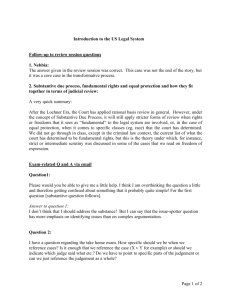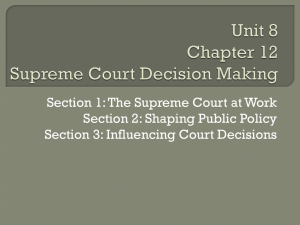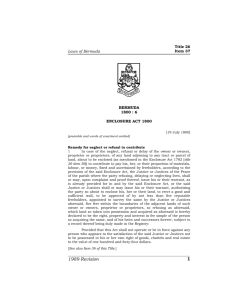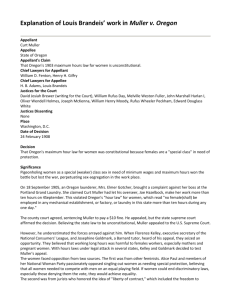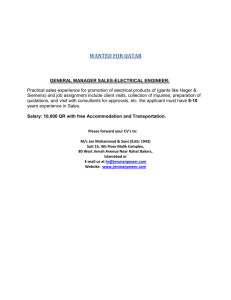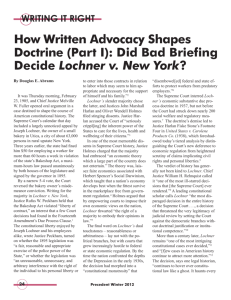Chapter 7 - Annenberg Classroom
advertisement
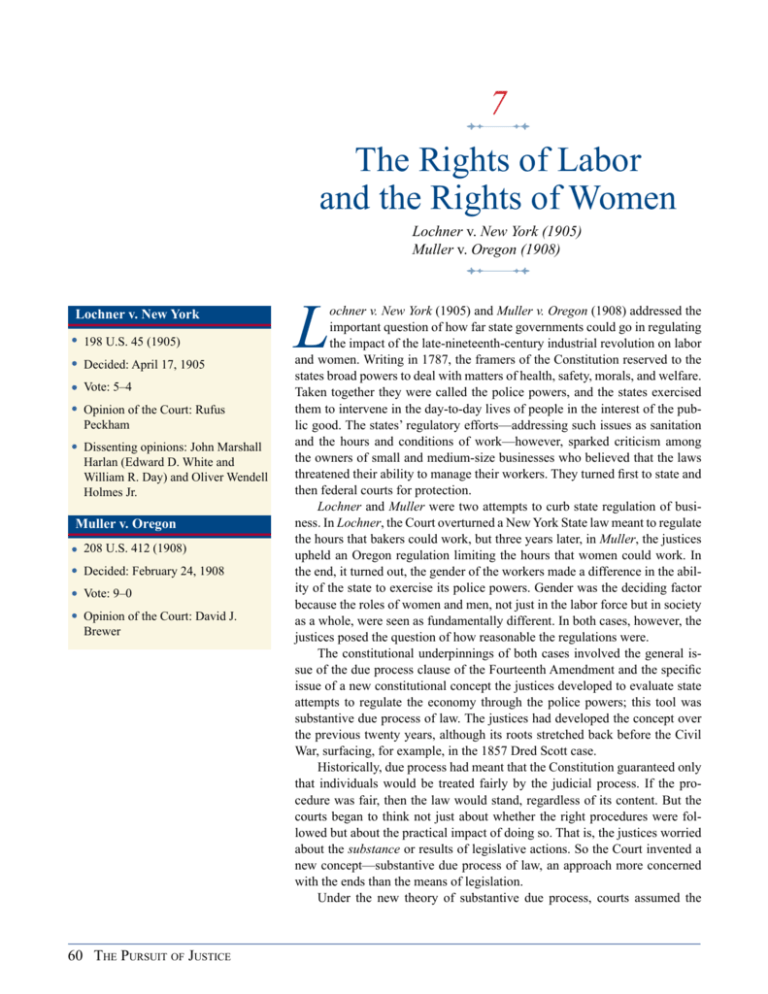
7 The Rights of Labor and the Rights of Women Lochner v. New York (1905) Muller v. Oregon (1908) s Lochner v. New York • • • • 198 U.S. 45 (1905) • Dissenting opinions: John Marshall Harlan (Edward D. White and William R. Day) and Oliver Wendell Holmes Jr. Decided: April 17, 1905 Vote: 5–4 Opinion of the Court: Rufus Peckham Muller v. Oregon • • • • 208 U.S. 412 (1908) Decided: February 24, 1908 Vote: 9–0 Opinion of the Court: David J. Brewer 60 The Pursuit of Justice L ochner v. New York (1905) and Muller v. Oregon (1908) addressed the important question of how far state governments could go in regulating the impact of the late-nineteenth-century industrial revolution on labor and women. Writing in 1787, the framers of the Constitution reserved to the states broad powers to deal with matters of health, safety, morals, and welfare. Taken together they were called the police powers, and the states exercised them to intervene in the day-to-day lives of people in the interest of the public good. The states’ regulatory efforts—addressing such issues as sanitation and the hours and conditions of work—however, sparked criticism among the owners of small and medium-size businesses who believed that the laws threatened their ability to manage their workers. They turned first to state and then federal courts for protection. Lochner and Muller were two attempts to curb state regulation of business. In Lochner, the Court overturned a New York State law meant to regulate the hours that bakers could work, but three years later, in Muller, the justices upheld an Oregon regulation limiting the hours that women could work. In the end, it turned out, the gender of the workers made a difference in the ability of the state to exercise its police powers. Gender was the deciding factor because the roles of women and men, not just in the labor force but in society as a whole, were seen as fundamentally different. In both cases, however, the justices posed the question of how reasonable the regulations were. The constitutional underpinnings of both cases involved the general issue of the due process clause of the Fourteenth Amendment and the specific issue of a new constitutional concept the justices developed to evaluate state attempts to regulate the economy through the police powers; this tool was substantive due process of law. The justices had developed the concept over the previous twenty years, although its roots stretched back before the Civil War, surfacing, for example, in the 1857 Dred Scott case. Historically, due process had meant that the Constitution guaranteed only that individuals would be treated fairly by the judicial process. If the procedure was fair, then the law would stand, regardless of its content. But the courts began to think not just about whether the right procedures were followed but about the practical impact of doing so. That is, the justices worried about the substance or results of legislative actions. So the Court invented a new concept—substantive due process of law, an approach more concerned with the ends than the means of legislation. Under the new theory of substantive due process, courts assumed the power to examine the content of legislation—its substance—notably its economic implications. The Supreme Court began in the late 1880s to invoke the doctrine to overrule state attempts at regulating railroads. From there the doctrine expanded as the justices used it increasingly to invalidate economic legislation enacted by states that they determined to be in conflict with key rights protected by the Constitution. The new doctrine, which the justices themselves had largely created, clothed them with additional authority to protect individual rights but at the same time turn aside the popular wishes of the people as expressed through state legislative enactments. Initially, substantive due process was applied to state legislative efforts to regulate the economy, but over the next century the justices extended it to other areas, notably to state limitations on birth control and abortion. Substantive due process meant that certain rights, not just economic rights, were so fundamental that the state could take them away only under the most extraordinary of circumstances. Lochner and Muller were important moments in the development of judicial power and attempts by the high court to address the demands of the new industrial era. They also mirrored the underlying and often contradictory values of that era. Americans wanted economic growth, but they were conflicted about how to distribute the benefits of that growth. Should corporations and businesses be free to do as they wished in order to produce the greatest wealth? Or was it better to regulate these activities, especially as workers and owners were often not equal in their bargaining power? In 1895 the New York legislature passed the Bakeshop Law, which regulated sanitary conditions in bakeries and limited the hours that bakers could work to ten per day and sixty per week. The law was a startling change for a business in which journeymen bakers often worked more than one hundred hours per week. There was a mix of motives behind passage of the law. Some legislators were genuinely concerned for the health of the workers. Bakers were exposed to flour dust, which produced a condition known as white lung disease, a type of emphysema with symptoms such as shortness of breath. The long hours also took a toll, particularly in cities, where bakeries were often located in the cramped, damp cellars of tenement houses. There was also a concern that consumers would suffer from unsafe and low-quality baked goods. Also, the baking business itself was changing. Small operators were being replaced by large corporate bakeries that often provided better working conditions and shorter hours. The bakers’ union was eager, therefore, to make sure that small and medium-sized bakeries became safe places to work. The new bakeshop laws had their fullest impact on small and medium-sized bakeries, not large operations whose scale permitted them to distribute the costs over many more productive workers. Union leaders actually found support for regulatory legislation from large bakeries because these large operators believed that the costs associated with the legislation would drive more and more smaller bakers out of business. The owners of the smaller bakeries, however, resisted regulation because they knew that their profits depended on their ability to control the terms under which they employed their bakers. If they could have fewer bakers working longer hours, they believed, they would be better able to compete with the large baking factories. The owners of small and medium-sized bakeries blasted the 1895 act known as the Bakeshop Law as an unwarranted governmental invasion of individual bakers’ rights to reach the best agreement they could with their employers. If The Rights of Labor and the Rights of Women 61 these workers wished to work long hours and earn more money, then the state should not stop them, especially as baking was not an unusually hazardous occupation. The case brought together an unusual cast of characters. Henry Weismann, the leader of the New York Journeymen Bakers’ Union, was a native of Germany who had helped to organize bakers in California before moving to New York City. There he joined with Edward Marshall, a muckraking reporter, to urge passage of the Bakeshop Law. Joseph Lochner, a so-called boss baker in Utica, New York, owned several small shops, the success of which depended on five or fewer assistant bakers. Like other boss bakers, Lochner worked on thin profit margins, which he maintained by regulating the hours that his assistants worked. In 1902 he was fined fifty dollars for allowing an employee to work more than sixty hours in one week. Lochner appealed his conviction to the appellate division of the New York Supreme Court, where he lost by a vote of 3 to 2. He then appealed to the New York Court of Appeals, where he lost again, in a 4-to-3 ruling. In one of the great ironies of Supreme Court and American constitutional history, the person who came to Lochner’s aid was none other than former labor leader Henry Weismann. After a falling out with the bakers’ union, Weismann had opened two bakeshops and became, like Lochner, an active member of the Master Bakers’ Association. He also studied law, although he never gained formal admission to the bar of the Supreme Court of the United States. Weismann is one of the few lawyers in the history of the Court to have argued and won a case before it without ever having been formally admitted to practice before the justices. He was granted “special permission” to appear before the Court. Arguments before the Court lasted for two days. With the help of attorney Frank Harvey Field, Weismann argued on Lochner’s behalf that the Bakeshop Law substantively violated the Fourteenth Amendment by depriving his client of life, liberty, or property without due process of law. The New York State law, he insisted, singled out bakers for regulation without any real justification for doing so. Weismann reminded the justices that homemakers, who also baked, were not covered by the law. He agreed that the state retained its historical police powers, but the New York State legislature did not have the right to invoke them in such a way that interfered with the “freedom to exercise a trade or calling.” If the Court had any doubt on the matter, Weismann continued, then it should err on the side of protecting individual liberty. Because baking was not a dangerous occupation, the state had no legitimate interest in attempting to regulate it, the way it might do, for example, with mining. Most important, Weismann insisted that the New York act was actually not a “labor law”; instead it was a piece of discriminatory social engineering that was inappropriate under the state’s police powers. New York’s attorney general, Julius M. Mayer, argued the case for the state. Mayer insisted that at trial Lochner had not raised any constitutional issues and he had in any case been found guilty, not once but twice, of violating the law. The act was a reasonable exercise of New York’s broad police powers, which should be viewed as “necessarily elastic” in order to address the new and changing conditions of industrial life. On the question of where to draw the line on the use of the police power, Mayer insisted that such a determination should be left to the legislative branch and not to the courts. To prove that the state had an interest in having a healthy work force, Mayer reminded the justices that bakers might be called to defend the state in a time of crisis. 62 The Pursuit of Justice The justices decided the case by a vote of five to four. Following two days of argument, the Court in conference initially gave the task of writing the opinion to Justice John Marshall Harlan, but he was unable to keep a majority when either Justices Henry Billings Brown or Joseph McKenna switched sides. Justice Peckham then emerged as the author of the majority opinion. Justice Rufus Peckham’s opinion for the Court held that in order for a law to pass constitutional muster, the legislature had to demonstrate that it was invoking the police power in a legitimate, fair, and reasonable way. Peckham rejected Mayer’s arguments about internal security and national defense, as he found that these criteria were so broad they could be used to justify almost any kind of state interference. Peckham also insisted that the Court had a duty to decide not only whether the legislature had the power to pass a law but whether the law itself was reasonable. According to Peckham the only reason to pass such regulatory legislation was to protect the health of the worker or the consumer, a tie that the justice concluded in this instance was “too shadowy and thin” to sustain the law. Baking might be unhealthful in some ways, he admitted, but it was not a dangerous occupation, and, in any case, the issue was not protection of the bakers but rather the health of the public as a whole. “[W]holesome bread,” Peckham wrote in one of the most memorable phrases of American constitutional history, “does not depend upon whether the baker works but ten hours per day or only sixty hours a week.” By asserting a standard of reasonableness in measuring a legislative act the justices were effectively becoming the final umpire of what was rational. And what was reasonable was to be measured by the results of the legislation, not whether it was passed according to established procedures. Peckham denounced the New York law as an infringement of the individual liberty of the bakers. The due process clause of the Fourteenth Amendment provided full protection to the bakers by clothing them and their workers with “liberty to contract.” Simply stated, this concept meant that both labor and management should be free of the interference of the state to negotiate the best possible arrangement among themselves. If the bakers and the workers found the terms acceptable, then the state was in no position to question their agreement. Peckham went even further. He concluded that the law was nothing more than “class legislation,” a measure designed to help one class—workers—at the expense of the other—owners. What was supposed to be a health regulation was actually a piece of social engineering, an activity that legislators should avoid at all costs. Justice Harlan, joined by Justices Edward D. White and William R. Day, authored one of two powerful dissents. Harlan claimed that employees did not stand on an equal footing with employers, so the state had a legitimate role in helping to restore the balance between them. Moreover, based on medical evidence, the legislature had a reasonable ground upon which to conclude that its police powers should be used to protect the bakers. As long as the legislature had such a reasonable basis to act, the Court should not interfere. “Unless they are plainly and palpably beyond all question in violation of the fundamental law of the Constitution,” Harlan explained, legislative enactments should be enforced. Justice Oliver Wendell Holmes Jr. added his own dissent and even more strongly articulated the idea that judges should defer to the wishes of legislators. He concluded that the statute did not infringe upon any fundamental liberties and that Peckham was simply dead wrong. Holmes echoed Harlan on the use of judicial power, asserting that the majority of justices had substituted their views The Rights of Labor and the Rights of Women 63 of what was reasonable for those of the New York legislature. Holmes also accused the majority of invoking a constitutional theory with which a majority of Americans and New York State citizens disagreed. A constitution, according to Holmes, was not meant to embody a particular economic theory, and the justices were bound to respect the will of the majority, even if they did not share its views. Holmes believed that the justices should defer to popular will instead of imposing their own views. “The Fourteenth Amendment had not enacted,” Holmes wrote in a now-famous phrase, “Mr. Herbert Spencer’s Social Statics.” Spencer was a British philosopher and sociologist who insisted that the human race progressed most effectively through a process of natural selection in which the rich and powerful dominated the poor and weak. According to his view of “social statics,” or the interactions among the classes, differences between the working and upper classes were not only inevitable but good, and he insisted that law should promote these differences. Lochner was the high point in the Court’s application of substantive due process of law against economic regulation. What made the case so controversial was that the justices took exception to a well-intentioned state effort to address the social and economic consequences of industrialization through a bold, almost breathtaking, use of judicial review. The majority of the Court made clear that they were prepared not just to weigh the constitutionality of a particular law but also to match their beliefs about how reasonable a law was against those of a legislative majority. Critics complained that the justices had become directly involved in formulating policy rather than interpreting the law. As Holmes pointed out, Lochner embraced one theory of the function of government at the expense of all others. Justice Peckham’s theory held that government should not engage in social engineering, but instead leave the marketplace to decide economic winners and losers. The responsibility of courts was to make sure that government did not intervene unreasonably. The opposing theory, articulated by Holmes, held that government had a duty to ensure a level economic playing field on which workers and management could bargain equally. The justices, therefore, were to give broad scope to legislative action because it represented the will of the people. For these reasons the case stands as a symbol of unrestrained judicial activism, in which the justices substituted their views for those of the legislature. In subsequent years, both state and federal courts did uphold many state regulations, but the justices invalidated others, including minimum wage laws, child labor laws, and regulations of the banking, insurance, and transportation industries. The courts found enough reform statutes unconstitutional that the history of constitutional law during the first third of the twentieth century came to be known as the Lochner era. In the more immediate term, the decision in Lochner generated rumors of a threatened national strike, but it never happened. The high court came under sharp attack for its decision in Lochner from reform groups, who charged that the justices were too eager to place the interests of management above those of labor. The Lochner ruling was widely interpreted as a blow to state regulation of hours in any nonhazardous occupation. Peckham’s opinion and Harlan’s dissent did agree in one area: if a connection could be made between the legitimate use of a state’s police power and a particular law, it would stand constitutional muster. The two justices simply disagreed on whether the facts in Lochner made such a connection. 64 The Pursuit of Justice This notion was tested three years later in Muller v. Oregon (1908). In this case, in stark contrast to Lochner, the justices unanimously accepted an Oregon law that limited the hours that women could work, leaving men as the only group clothed by the “protection” of liberty to contract that was established in Lochner. In 1903, Oregon set a maximum of ten hours of work a day for women employed in factories and laundries. The rationale behind the legislation was simple: women were the weaker sex and therefore required protection from the ravages of industrialization. But on September 4, 1905, Joe Haselbock, a foreman in the Grand Laundry run by Curt Muller in Portland, Oregon, ordered one of his female employees to work more than ten hours a day. The employee took Muller to court; two weeks later the owner was convicted of violating the ten-hour law and fined ten dollars. Muller then appealed to the Oregon Supreme Court, which upheld his conviction. Bolstered by the decision in Lochner, Muller appealed to the U.S. Supreme Court. The result was entirely different from what Muller expected. Louis D. Brandeis, who argued the case for the state of Oregon, was the force that drove the reversal in the Court’s opinion.. The National Consumers’ League, a group devoted to social reform measures, persuaded Oregon’s attorney general to hire Brandeis, one of the nation’s most accomplished lawyers and a progressive advocate of social change through the law. Brandeis, with the assistance of Florence Kelley and his sister-in-law Josephine Goldmark, who were officials of the league, constructed a novel brief in support of the Oregon law. Instead of focusing directly on the law in question and on the precedents set by the Court in previous rulings, Brandeis instead amassed evidence that demonstrated that women’s health problems and long hours of work were directly connected to one another. The two women exhaustively compiled for Brandeis every medical and governmental report dealing with the relationship of working conditions and women’s health, not just in the United States but around the world. Brandeis then translated this material into more than one hundred pages of the most pointed and poignant excerpts from these reports, while giving only two pages to the legal precedents. The brief made clear that Oregon was not alone in it approach to the dangers posed by long hours of work to women’s health; other states and nations had used government power to preserve women’s well-being. Brandeis did the same in his oral argument, reminding the justices that the majority in Lochner had agreed that if it could be demonstrated that there was a rational state interest in regulation it would survive judicial scrutiny. What, Brandeis essentially asked, could be more important that preserving the health of women? The Court answered unanimously: nothing. Justice David J. Brewer upheld the law and praised Brandeis for his brief and oral presentation. Thereafter, a new form of brief, or written argument, known as the Brandeis brief, emerged before the Court, as lawyers turned increasingly to social science data to complement their legal arguments. The importance of the new reasonableness test became immediately clear. What the justices thought was reasonable now became the law. Justice Brewer’s opinion found that the state of Oregon acted rationally in passing the legislation, even though this seemed to contradict the finding only three years earlier in Lochner. Why was the law reasonable? Because women were different from men. The Court acknowledged that a “woman’s physical structure and the performance of maternal functions place her at a disadvantage in the struggle for The Rights of Labor and the Rights of Women 65 subsistence.” Women were not only the weaker sex and therefore in need of greater state protection than men, but they also had a special role in society as mothers that government was obligated to foster. Long hours of labor would take a toll on women. “And as healthy mothers are essential to vigorous offspring, the physical well-being of women becomes an object of public interest and care,” Brewer concluded. The decision underscored the paternalism men directed toward women and the latter’s second-class citizenship. Because men were “tougher” they could enjoy a greater level of “liberty to contract”; women, on the other hand, because of their supposed inherent physical weakness, were granted a lower degree of constitutional protection of their rights and accorded a higher level of state interference to protect their well-being. The conflict with the earlier Lochner decision was clear. And Justice Brewer went out of his way to note that the decision in Muller did not “in any respect” weaken either the doctrine of substantive due process or the importance of the holding in Lochner. Despite Brewer’s assurances, the application of substantive due process to matters of economic regulation shifted over the next two decades from unsettled to uncertain to unsupportable. The Court in Bunting v. Oregon (1917) accepted another Oregon law that limited the hours of all factory workers, but it invoked the doctrine of liberty to contract, and with it substantive due process of law, in Adkins v. Children’s Hospital (1923). The justices in Adkins prohibited Congress from authorizing a commission to establish minimum wages in the District of Columbia. The Great Depression of the 1930s demonstrated that the economic assumption behind the Lochner decision, that each worker should be left to make the best possible contract for his work, was untenable given the uneven balance of power between labor and business. While the application of substantive due process to economic regulation waned, the doctrine itself retained considerable vitality. A new generation of justices beginning in the 1960s resurrected it as a means of reaching behind the text of the Constitution to address whether other noneconomic regulations were reasonable. They often concluded that they were not. The justices identified a host of new fundamental rights, including such hot-button matters as privacy, birth control, and abortion, that are nowhere mentioned in the Constitution, as well as less controversial issues including the rights of women, the disabled, and immigrants. The shadow of Lochner continues to fall over these and other areas of contemporary American law as its underlying doctrine of substantive due process grants the justices a controversial ability to adapt constitutional law to changing social practices. 66 The Pursuit of Justice The Dangers of Long Hours Louis D. Brandeis was known in the early twentieth century as the People’s Attorney because of his prominent role in advocating public-interest causes. Brandeis pressed his social agenda through legal briefs laden with sociological evidence rather than legal precedent. These “Brandeis briefs” recognized that when courts considered the reasonableness of legislation, evidence of the social circumstances and the impact of constitutional doctrines might persuade judges and justices. The 1908 Muller v. Oregon case was noteworthy because both Brandeis’s brief (below) and the Court’s ruling dovetailed with the prevailing societal view that because of their physical limitations, women had to be treated differently than men when it came to hours and conditions of work. THE WORLD’S EXPERIENCE UPON WHICH THE LEGISLATION LIMITING THE HOURS OF LABOR FOR WOMEN IS BASED I. The Dangers of Long Hours A. Causes (1) Physical Differences Between Men and Women Report of Select Committee on Shops Early Closing Bill, British House of Commons, 1895. Dr. Percy Kidd, physician in Brompton and London Hospitals: The most common effect I have noticed of the long hours is general deterioration of health; very general symptoms which we medically attribute to over-action, and debility of the nervous system; that includes a great deal more than what is called nervous disease, such as indigestion, constipation, a general slackness, and a great many other indefinite symptoms. Are those symptoms more marked in women than in men? I think they are much more marked in women. I should say one sees a great many more women of this class than men; but I have seen precisely the same symptoms in men, I should not say in the same proportion, because one has not been able to make anything like a statistical inquiry. There are other symptoms, but I mention those as being the most common. Another symptom especially among women is anemia, bloodlessness or pallor, that I have no doubt is connected with long hours indoors. Report of the Massachusetts Bureau of Labor and Statistics, 1875. A “lady operator,” many years in the business, informed us: “I have had hundreds of lady compositors in my employ, and they all exhibited, in a marked manner, both in the way they performed their work and in its results, the difference in physical ability between themselves and men. They cannot endure the prolonged close attention and confinement which is a great part of type-setting. I have few girls with me more than two or three years at a time; they must have vacations, and they break down in health rapidly. I know no reason why a girl could not set as much type as a man, if she were as strong to endure the demand on mind and body.” Report of the Nebraska Bureau of Labor and Industrial Statistics, 1901B1902. They (women) are unable, by reason of their physical limitations, to endure the same hours of exhaustive labor as may be endured by men without injury to their health [which] would wreck the constitution and destroy the health of women, and render them incapable of bearing their share of the burdens of the family and the home. The State must be accorded the right to guard and protect women as a class against such a condition, and the law in question to that extent conserves the public health and welfare. In strength as well as in rapidity and precision of movement women are inferior to men. This is not a conclusion that has ever been contested. It is in harmony with all the practical experience of life. It is perhaps also in harmony with the results of those The Rights of Labor and the Rights of Women 67 investigators who have found that, as in the blood of women, so also in their muscles, there is more water than in those of men. To a very great extent it is a certainty, a matter of difference in exercise and environment. It is probably, also, partly a matter of organic constitution. The motor superiority of men, and to some extent of males generally, is, it can scarcely be doubted, a deep-lying fact. It is related to what is most fundamental in men and in women, and to their whole psychic organization. There appears to be a general agreement that women are more docile and amenable to discipline; that they can do light work equally well; that they are steadier in some respects; but that, on the other hand, they are often absent on account of slight indisposition, and they break down sooner under strain.... It has been estimated that out of every one hundred days women are in a semi-pathological state of health for from fourteen to sixteen days. The natural congestion of the pelvic organs during menstruation is augmented and favored by work on sewing machines and other industrial occupations necessitating the constant use of the lower part of the body. Work during these periods tends to induce chronic congestion of the uterus and appendages, and dysmenorrhea and flexion of the uterus are well known affections 68 The Pursuit of Justice of working girls.... D. Bad Effect upon Morals Report of British Chief Inspector of Factories and Workshops, 1900. One of the most unsatisfactory results of the present system of lack of working hours in laundries is the unfortunate moral effect on the women and girls. Women who are employed at arduous work till far into the night are not likely to be early risers nor given to punctual attendance in the mornings, and workers who on one or two days in the week are dismissed to idleness or to other occupations, while on the remaining days they are expected to work for abnormally long hours, are not rendered methodical, industrious, or dependable workers by such an unsatisfactory training. The self-control and good habits engendered by a regular and definite period of moderate daily employment, which affords an excellent training for the young worker in all organized industries, is sadly lacking, and, instead, one finds periods of violent over-work alternating with hours of exhaustion. The result is the establishment of a kind of “vicious circle”; bad habits among workers make compliance by their employers with any regulation as to hours very difficult while a lack of loyal adherence to reasonable hours of employment by many laundry occupiers increases the difficulty for those who make the attempt in real earnestness.

